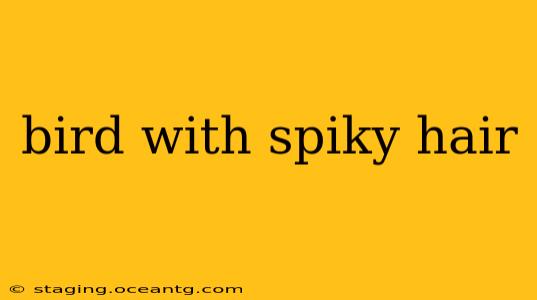Many birds boast incredible plumage, but some stand out with truly striking head crests or "spiky hair." This isn't just for show; these unique features often serve vital purposes in communication, courtship, and even thermoregulation. Let's explore some of these feathered friends with their impressive, spiky styles.
What Birds Have Spiky Hair?
This is a broad question, as "spiky hair" can refer to a range of head crests and feather arrangements. Several bird species exhibit variations on this theme. Some examples include:
- Spix's Macaw: This critically endangered parrot has a distinct, somewhat spiky crest that adds to its already striking blue plumage. The crest's movement can communicate the bird's emotional state.
- Southern Cassowary: This large, flightless bird from Australia and New Guinea possesses a prominent casque on its head – a bony structure covered in keratin. While not technically "hair," its spiky texture and appearance contribute to its unique look. The exact function of the casque is debated but likely plays a role in display and foraging.
- Various Hornbills: Many hornbill species exhibit a prominent casque on their beaks. These casques, while not feathers, often have a spiky or textured appearance and are important for visual communication and species identification.
- Many species of crested birds: Numerous bird species, such as some species of titmice, grebes, and even some owls, feature crests which, depending on the species, can appear spiky or ruffled. These crests are often raised during displays of aggression or excitement.
What Causes a Bird's "Hair" to be Spiky?
The "spiky" appearance of a bird's head feathers stems from several factors:
- Feather Structure: The individual barbs that make up a feather can be stiff and relatively independent, leading to a spiky or textured appearance.
- Muscle Control: Many birds have muscles at the base of their head feathers allowing for controlled raising and lowering of their crests, further contributing to the spiky effect when raised.
- Environmental Factors: Humidity and weather conditions can affect feather appearance, potentially making them appear spiker in certain circumstances.
How Do Birds Use Their Spiky Hair?
The functions of these "spiky" head features vary significantly depending on the species:
- Courtship Displays: In many species, the raising and lowering of crests is a key element of courtship displays. Birds with larger or more prominent crests often have greater reproductive success.
- Social Signaling: Spiky crests can communicate a bird's emotional state, such as aggression, fear, or excitement.
- Species Recognition: The unique structure and appearance of head crests can help birds identify members of their own species.
- Thermoregulation: In some cases, the crest can contribute to thermoregulation, helping the bird regulate its body temperature.
Why Do Some Birds Have Spiky Hair and Others Don't?
The evolution of spiky head crests is a complex process influenced by several factors including:
- Sexual Selection: Elaborate crests are often favored in mate selection, leading to the evolution of more prominent features.
- Natural Selection: The presence or absence of a crest may also relate to other survival pressures, such as camouflage or predator avoidance. Some birds may have evolved smoother, less spiky feathers for better camouflage in their habitat.
- Genetic Drift: Random fluctuations in gene frequencies can also contribute to the diversity of feather structures among birds.
Are Spiky Head Crests Always "Hair"?
It's important to clarify that while we use the term "spiky hair" colloquially, this isn't true hair like that found on mammals. The spiky structures are modified feathers. Some birds have bony structures like the cassowary's casque, which is not made of feathers at all.
This exploration delves into the fascinating world of bird plumage. The diverse array of head crests and their functions highlights the remarkable adaptations found in the avian world. Further research into specific bird species will reveal even more intricacies within this captivating aspect of avian biology.
